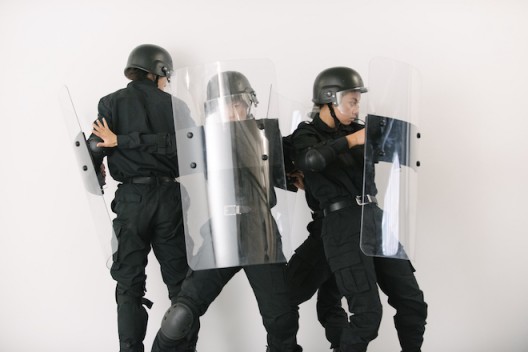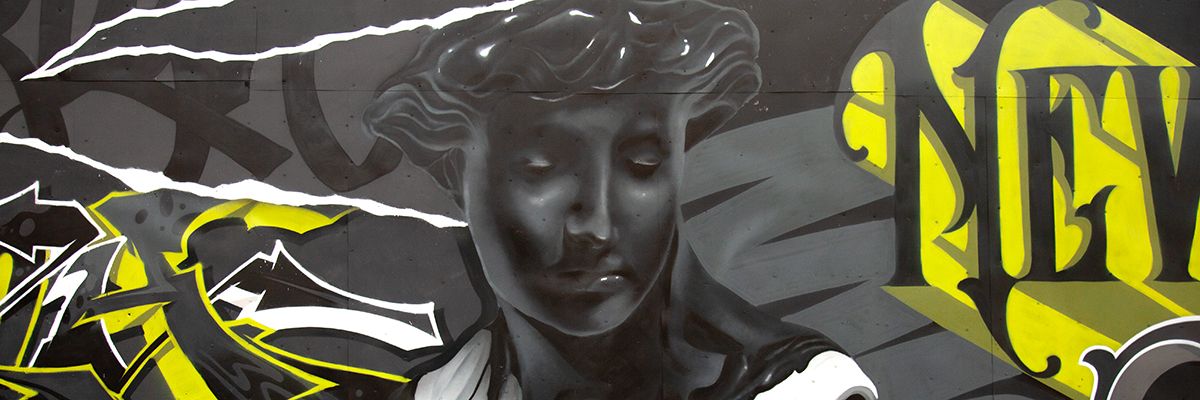I am the Greatest
2012 - Painting (Painting)
33.5 inches in diameter
Hank Willis Thomas
Like many of his other sculptural works, the source of I am the Greatest is actually a historical photograph of an identical button pin from the 1960s. I am the Greatest presents the famous quote by Mohammad Ali to think about his important presence in the African American community. In dialogue with the painting I am a Man, also in the Kadist collection, this assertion that begins the same way takes the line from the protest poster several steps further. Ali never asserted that he was the greatest boxer or athlete, but had the audacity to claim that he was THE GREATEST [human being] of all time. For a man who grew up in the segregated south to rise to Ali’s iconic status and to be able to confidently and proudly vocalize his superiority was one of the most powerful, symbolic, and memorable moments in the Civil Rights struggle. Monumentally inflating the scale of the button embodies the ‘larger than life’ presence of Ali as an icon for African Americans to stand up and not only assert their humanity, but to be confident in their ability to succeed and rise up against all obstacles society placed in front of them.
Employing the visual language and terminology of mass media, and appropriating symbols and images from popular culture, Hank Willis Thomas’ work seeks to question and subvert established definitions and positions with regards to personal identity and the narrative of race. Working across installation, photography, video, and media work, Thomas maintains his photo conceptualist roots, primarily taking source material from found photographs and archives. These images form the basis from which the artist seeks to uncover the fallacies that history claims as truth. His work illustrates how the way history is represented and consumed reinforces generalizations surrounding identity, gender, race and ethnicity, and that as an artist he has an opportunity to expose or to revise those histories from the points of view of the oppressed.
Colors:
Related works of genres: » born 1976, » california college of the arts alumni, » contemporary artist, » conceptual artist, » african-american photographers
» see more

© » KADIST
Raymond Pettibon
2005The five works included in the Kadist Collection are representative of Pettibon’s complex drawings which are much more narrative than comics or cartoon...

© » KADIST
Paul McCarthy
2008Memory Mistake of the Eldridge Cleaver Pants was created for the show Paul McCarthy’s Low Life Slow Life Part 1 , held at California College of the Arts’s Wattis Institute in 2008 and curated by McCarthy himself...
Related works featuring themes of: » Advertising and Brands, » Cultural Commentary, » Contemporary Conceptualism, » Cultural Identity, » Mass Media, » Appropriation Art, » Racial Identity, » Collective History, » Color Photography, » American
» see more

© » KADIST
Glenn Ligon
2000Glenn Ligon’s diptych, Condition Repor t is comprised of two side-by-side prints...

© » KADIST
Carlos Amorales
2006This work, a large oil painting on canvas, shows a moment from Amorales’s eight-minute two-channel video projection Useless Wonder (2006)...

© » KADIST
Mungo Thomson
2008The White Album (2008) presents a compilation of one hundred issues of Artforum magazine released between 1970 and 1979...
Other related works, blended automatically
» see more

© » KADIST
Hank Willis Thomas
2014South Africa Righteous Space by Hank Willis Thomas is concerned with history and identity, with the way race and ‘blackness’ has not only been informed but deliberately shaped and constructed by various forces – first through colonialism and slavery, and more recently through mass media and advertising – and reminds us of the financial and economic stakes that have always been involved in representations of race....

© » KADIST
Glenn Ligon
2000Glenn Ligon’s diptych, Condition Repor t is comprised of two side-by-side prints...

© » KADIST
Du Zhenjun
2010The Tower of Babel is an installation of large-format photographs that forces the audience to occupy a central position through its monumental scale...
Related works sharing similar palette
» see more

© » SLASH PARIS
Jean Miotte — Galerie Almine Rech — Exposition — Slash Paris Connexion Newsletter Twitter Facebook Jean Miotte — Galerie Almine Rech — Exposition — Slash Paris Français English Accueil Événements Artistes Lieux Magazine Vidéos Retour Jean Miotte Exposition Peinture Jean Miotte, Sans titre, 2000 (Détail) Acrylique sur toile — 99,1 × 81,3 × 2,5 cm Courtesy of the artist & Galerie Almine Rech, Paris Jean Miotte Encore 11 jours : 18 novembre → 22 décembre 2023 Jean Miotte (1926-2016), qui a exposé à Paris avec Joan Mitchell, Jean-Paul Riopelle et Sam Francis, est une des figures éminentes de l’abstraction lyrique...

© » KADIST
Luke Murphy
2016What Color is Luke Murphy’s outstanding digital painting that elegantly loops in nonstop motion...

© » SLASH PARIS
Tia-Thuy Nguyen — Sparkle in the vastness — Almine Rech Gallery, Matignon — Exhibition — Slash Paris Login Newsletter Twitter Facebook Tia-Thuy Nguyen — Sparkle in the vastness — Almine Rech Gallery, Matignon — Exhibition — Slash Paris English Français Home Events Artists Venues Magazine Videos Back Previous Next Tia-Thuy Nguyen — Sparkle in the vastness Exhibition Painting Tia Thuy Nguyen, série I, my, me, cloud (2018-2023) Courtesy de l’artiste et galerie Almine Rech Tia-Thuy Nguyen Sparkle in the vastness Ends in 13 days: January 11 → February 24, 2024 “Sparkle in the vastness", Tia-Thuy Nguyen’s first show with Almine Rech presents a suite of more than twenty multi-media paintings from the artist’s ongoing series “I, my, me, cloud” (2018–)...
Related works from the » 2010's created around » New York, New York
» see more

© » KADIST
Chris Wiley
2012Architectural details become abstracted renderings in Chris Wiley’s inkjet prints 11 and 20 (both 2012)...

© » KADIST
Oded Hirsch
2012Oded Hirsch’s video work Nothing New (2012) utilizes seemingly absurdist tropes to raise more trenchant questions about communal action and collective identity in modern day Israel...

© » KADIST
Juliana Huxtable
2017Herculine’s Prophecy by Juliana Huxtable features a kneeling demon-figure on what appears to be a screen-print, placed on a wooden table, which has then been photographed and digitally altered to appear like a book cover, with a title and subtitle across the top, and a poem written across the bottom...
Other works by: » Hank Willis Thomas
» see more

© » KADIST
Hank Willis Thomas
2014South Africa Righteous Space by Hank Willis Thomas is concerned with history and identity, with the way race and ‘blackness’ has not only been informed but deliberately shaped and constructed by various forces – first through colonialism and slavery, and more recently through mass media and advertising – and reminds us of the financial and economic stakes that have always been involved in representations of race....

© » KADIST
Hank Willis Thomas
2013The image is borrowed from protests during Civil Rights where African Americans in the south would carry signs with the same message to assert their rights against segregation and racism...

© » KADIST
Hank Willis Thomas
2014Shot in black and white and printed on a glittery carborundum surface, Black Hands, White Cotton both confronts and abstracts the subject of its title...
Related artist(s) to: Hank Willis Thomas » Abraham Cruzvillegas, » Claire Fontaine, » William E Jones, » Catherine Opie, » Collier Schorr, » Glenn Ligon, » Harun Farocki, » Jens Hoffmann, » Kirsten Pieroth
» see more

© » KADIST
Claire Fontaine
2006Foreigners Everywhere is a series of neon signs in several different languages...

© » KADIST
Glenn Ligon
2000Glenn Ligon’s diptych, Condition Repor t is comprised of two side-by-side prints...

© » KADIST
Catherine Opie
1987In this work, a woman sits on a couch with her shirt pulled up to expose her pierced nipples, which are connected by a chain...

© » KADIST
Abraham Cruzvillegas
2004Wright Imperial Hotel (2004) is a sort of bow and arrow made out of feathers, a São Paulo phone book, and other materials...
Related works found in the same semantic group
» see more

© » KADIST
Taus Makhacheva
2012For Taus Makhacheva, the wild, untamed side of human nature is often the foundation of many of her formal investigations...

© » KADIST
Francis Alÿs
2006This series of small drawings is executed with varying materials—pen, ink, colored pencil, charcoal, and masking tape—on architect’s tracing paper...








